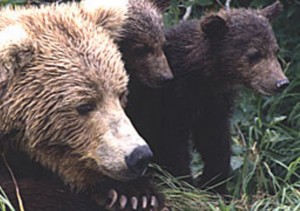
Statewide) — From Alaska’s southern reaches north to Fairbanks and points beyond, word has it that bears are waking and starting to move. And that can mean only one thing: It’s time for Alaskans to assume their best “bear aware” behavior.
“We had a report the other day of a grizzly out around Nordale Road,” said Jesse Dunshie, a fish and wildlife technician in the Alaska Department of Fish and Game’s Fairbanks office. That was one of a couple bear-related calls he’s received in recent days.
Indeed, unseasonably mild weather may be rousing bears earlier than usual in some parts of the state. In Anchorage, black bears have been spotted in several areas around the city. Reports in Kodiak have included sightings of brown bear sows and yearling cubs which normally don’t appear until later in the season. And in Southeast, recent warm days have skunk cabbage and other wild greens blooming, setting the stage for bears there to start moving any day.
In light of these early signs, Gov. Bill Walker has proclaimed April Bear Awareness Month. The official proclamation recognizes that “our state abounds in bear country,” and that “April is a good time to remind Alaskans about bears, their behavior, and how we can live responsibly and safely in bear country.”[xyz-ihs snippet=”adsense-body-ad”]
Anchorage Area Wildlife Biologist Dave Battle agrees. “Right now is the time to be proactive,” he said, “before we start getting a lot of calls and complaints. Take down bird feeders and clean up any seed, trash or pet food left out over the winter.”
Bears that associate homes and people with food, often return. Feeding bears, even unintentionally, is illegal and leaving attractants out around homes, cabins or camps in a manner that attracts bears can result in fines.
To prevent drawing bears, bird feeders should be kept down at least through October. Pet and livestock foods, trash and other bear attractants should be gathered and stored in a secure, closed building or in bear-resistant containers. Owners of poultry, goats and other small livestock can discourage hungry bears by erecting electric fences.
Some tips to remember as bears become active include the following:
- Garbage – Store trash inside buildings or in bear-proof containers; keep secured until the day of scheduled pickup. Encourage neighbors to do the same.
- Electric fences – Electric fences can keep bears out of gardens, compost, and away from buildings, chicken coops, and domestic animals. For more information, contact your area department office or the visit the department webpage at www.adfg.alaska.gov/index.cfm?adfg=livingwithbears.bearfences.
- Barbecues – Clean barbecue grills, especially grease traps, after each use.
- Pets – Feed pets indoors or clean up excess and spilled food between meals. Store pet food, livestock food and birdseed indoors or in bear-resistant containers.
- Bird Feeders – Take feeders down April through October, store out of bears’ reach and remove spilled seeds.
- Freezers – Keep freezers locked in a secure building or otherwise out of bears’ reach.
- Gardens – Plant gardens in the open, away from cover and game trails. Only compost raw vegetable matter and turn over compost frequently.
Moose carcasses emerging from melting snows can attract bears in the spring, said Kenai Area Wildlife Biologist Jeff Selinger.
“We had 70 to 80 moose reported hit by vehicles over the winter and not recovered,” he said.
Brown bears tend to be particularly defensive of these food sources and carcasses that appear near trails or in populated areas can create hazards. Selinger suggests property owners, hikers and others stay alert for these winterkills and avoid them.
Incidents of bears frequenting carcasses in neighborhoods or other populated areas, getting into trash, showing aggression, or related concerns should be reported to the nearest Department of Fish and Game office during regular business hours; if the situation involves an immediate public safety concern, contact the Alaska State Troopers.
“So many situations go unreported, or we hear rumors days later via social media,” said Dave Battle in Anchorage. “We want to know any time brown bears are seen in town or populated areas, and people should let us know whenever they see bears in trash or feeding on human provided food.”
To learn more about coexisting with bears, call or visit your local department office or see the webpages atwww.alaskabears.alaska.gov. The governor’s “Bear Awareness Month” proclamation is available athttps://gov.alaska.gov/newsroom/2016/04/bear-awareness-month-2/.
Source: ADF&G
